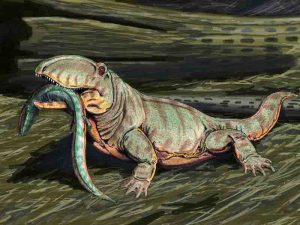
Warm-bloodedness in land animals could have developed in evolution much earlier than previously thought. This is shown by a recent study at the University of Bonn, which has now been published in the journal Comptes Rendus Palevol.
People who like watching lizards often get the best opportunity to do so in the morning, as they can usually be found sunbathing at this time of day. This is because they rely on an external energy supply to reach their operating temperature. However, mice and other mammals make themselves nice and cozy in a different way: they burn calories and can even keep themselves warm during a bitterly cold winter’s night.
Mammals are thus referred to as warm-blooded. Until now, it was thought that the “body heater” was invented in four-legged land animals around 270 million years ago. “However, our results indicate that warm-bloodedness could have been created 20 to 30 million years earlier,” explains Prof. Martin Sander from the Steinmann Institute for Geology, Mineralogy and Paleontology at the University of Bonn.
Bones as a thermometer
For long-extinct animals, it is naturally not possible to simply determine body temperature using a thermometer. However, warm-bloodedness leaves behind tell-tale signs in fossils. It not only means that the animal is not reliant on the ambient temperature, but also enables faster growth. “And this is shown in the structure of the bones,” explains Sander.
Bones are composites of protein fibers, collagen, and a biomaterial, hydroxyapatite. The more orderly the arrangement of the collagen fibers, the more stable the bone, but the more slowly it normally grows as well. The bones of mammals thus have a special structure. This allows them to grow quickly and yet remain stable. “We call this bone form fibrolamellar,” says the paleontologist.
Together with his PhD student Christen D. Shelton (now at the University of Cape Town), the scientist looked at humerus bones and femurs from a long-extinct land animal: the mammal predecessor Ophiacodon. This lived 300 million years ago. “Even in Ophiacodon, the bones grew as fibrolamellar bones,” says Sander to summarize the analysis results. “This indicates that the animal could already have been warm-blooded.”
Ophiacodon was up to two meters long, but otherwise resembled today’s lizards — and not without good reason: mammals and reptiles are related; they thus share a predecessor. In the family tree, Ophiacodon is very close to the place where these two branches separate.
Were the first reptiles warm-blooded?
However, lizards, turtles and other reptiles living today are cold-blooded. Until now, it has been assumed that this was the original form of the metabolism — i.e. that the shared ancestor of both animal groups was cold-blooded. Warm-bloodedness would thus be a further development, which arose over the course of mammalian evolution.
However, Ophiacodon appears a very short time after the division between mammals and reptiles. “This raises the question of whether its warm-bloodedness was actually a completely new development or whether even the very first land animals before the separation of both branches were warm-blooded,” says Sander. That is just speculation. However, if this theory is correct, we would have to drastically correct our image: the first reptiles would then also have been warm-blooded — and would have only discarded this type of metabolism later.
Reference:
Christen D. Shelton, Paul Martin Sander. Long bone histology of Ophiacodon reveals the geologically earliest occurrence of fibrolamellar bone in the mammalian stem lineage. Comptes Rendus Palevol, 2017; DOI: 10.1016/j.crpv.2017.02.002
Note: The above post is reprinted from materials provided by University of Bonn.










